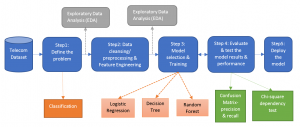Predicting Customer Churn using Machine Learning

Introduction
Churn occurs when customers stop doing business with a company. Customer retention is of paramount importance to companies because the cost of acquiring new customers is high. Customer churn occurs due to a multitude of reasons: complicated on-boarding, lack of clarity about products & their usage, poor communication, etc.
Types
Voluntary Churn
Voluntary churn occurs when a customer voluntarily switches to another company or service.
Involuntary Churn
Involuntary churn occurs due to uncontrollable external factors such as death, relocation, etc.
How is customer churn predicted?
Customer churn prediction can be done using either classification or regression models.

Classification
The goal of classification is to determine to which class or category a data point (customer in our case) belongs to. The data used for classification models is historical data with pre-defined target variables or labels (churn/no churn) – answers that need to be predicted – for training the algorithm (binary classification). A classification model helps businesses answer the following questions:
- Will a customer churn or not?
- Are there any signs of unusual customer behaviour?
- Will a customer downgrade their pricing plan?
- Will a customer renew their subscription?
Unusual customer behaviour can also be detected as a separate task using a classification method known as anomaly detection. Anomaly detection helps identify outliers – data points that are highly deviant from the rest of the data.
Decision trees are usually considered for classifying customers based on their behaviour. Decision trees are well-known due to their ease of use and interpretation of binary classification. The problem with decision trees is their instability. This can be corrected by using random forest algorithm.
Conclusion
Reducing customer churn is important because it helps ensure that you’re receiving adequate feedback on existing issues in your business. This will inspire you to improve customer service, which, in turn, reduces customer churn. If you find your rate of customer churn exceeding beyond acceptable levels, it is a clear indication that steps need to be taken to improve both the value and the customer service you are providing to your customers.
